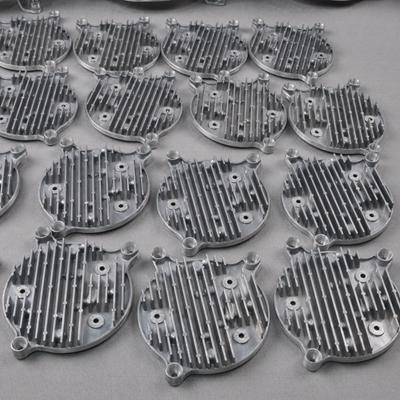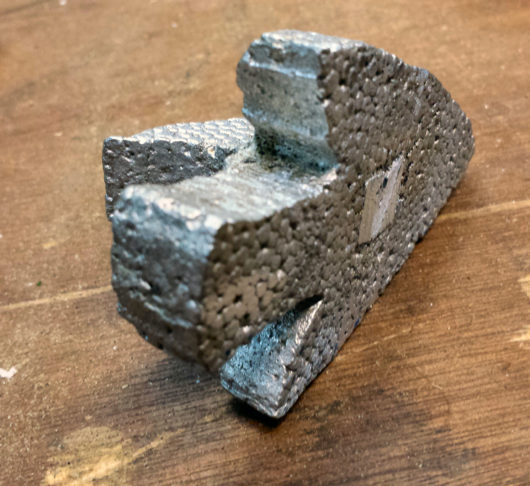Everything About Aluminum Casting: Discovering Its Benefits and Applications in Modern Manufacturing
aluminum casting plays a vital duty in contemporary production. It provides a variety of benefits, such as lightweight residential properties and excellent corrosion resistance. Industries from aerospace to consumer electronic devices rely upon aluminum casting for its versatility. As automation and sustainability gain grip, the procedure is advancing. Recognizing the complexities of aluminum casting exposes its significance and capacity. What patterns and developments are shaping its future?
The Aluminum Casting Process: An Overview
The aluminum casting procedure changes raw aluminum into specific elements with a collection of systematic actions. At first, aluminum is melted in a heater, reaching temperatures in between 660 ° C and 750 ° C. Once molten, the liquid aluminum is put into mold and mildews designed to shape the end product. Three typical casting techniques are sand casting, die casting, and investment casting, each offering distinct benefits customized to details applications.
After the aluminum cools down and solidifies, the mold and mildews are gotten rid of, revealing the actors component. Consequently, any kind of excess product, understood as flash, is trimmed away. Additional operations, such as machining or surface finishing, might be done to achieve wanted dimensions and surface area top quality - Precision aluminum casting. Quality assurance examinations verify that the components satisfy accurate requirements. This intricate procedure allows suppliers to develop lightweight, intricate shapes that offer varied sectors, from auto to aerospace
Benefits of Aluminum Casting
While various metal casting processes exist, aluminum casting sticks out as a result of its countless benefits. One significant advantage is its light-weight nature, which adds to reduced energy intake in transportation and manufacturing. In addition, aluminum displays excellent rust resistance, ensuring long life and resilience in different settings. The thermal and electric conductivity of aluminum likewise makes it a perfect selection for applications requiring reliable warmth dissipation and electric conductivity.
On top of that, aluminum casting allows for elaborate layouts and complicated geometries, allowing producers to create thorough elements with accuracy. The procedure generally results in a smooth surface finish, reducing the requirement for comprehensive post-processing. Moreover, aluminum is very recyclable, advertising sustainability in producing practices. Its ability to be cast in different forms, such as sand, die, or financial investment casting, offers adaptability in manufacturing techniques. Generally, these advantages make aluminum casting a preferred selection in contemporary production throughout several industries.
Applications of Aluminum Casting in Different Industries
aluminum casting plays a vital function in numerous crucial sectors, consisting of aerospace, vehicle, and customer electronics. Its light-weight and sturdy homes make it a perfect selection for making components such as aircraft parts, automobile housings, and digital rooms. As industries proceed to focus on performance and efficiency, the applications of aluminum casting are most likely to broaden better.
Aerospace Element Production
As the aerospace market significantly requires lightweight yet long lasting products, aluminum casting has emerged as an essential remedy for making important parts. The process permits the creation of complex geometries that are necessary in airplane layout, such as engine installs, architectural structures, and various fittings. aluminum's excellent strength-to-weight proportion adds to sustain effectiveness and overall performance, making it a favored option for aerospace applications. In addition, aluminum castings offer exceptional corrosion resistance, an essential consider the extreme atmospheres experienced during trip. The precision of aluminum casting techniques allows makers to generate components that fulfill rigid aerospace requirements, making sure reliability and safety and security. This adaptability and efficiency make aluminum casting an indispensable property in the advancing landscape of aerospace element manufacturing.
Automotive Components Production
Changing the vehicle sector, aluminum casting plays an important function in the manufacturing of light-weight yet robust elements. This process permits suppliers to produce elaborate designs and shapes that improve vehicle performance and efficiency - Aluminum Foundry. Secret vehicle parts generated through aluminum casting include engine blocks, transmission real estates, and suspension parts. The lightweight nature of aluminum adds to enhanced gas effectiveness and decreased discharges, lining up with contemporary environmental criteria. Furthermore, aluminum's superb rust resistance prolongs the life expectancy of auto components, better improving dependability. The convenience of aluminum casting makes it possible for automobile designers to innovate, incorporating advanced modern technologies and optimizing layouts. As electric vehicles gain grip, the demand for aluminum elements is anticipated to rise, strengthening its importance in future auto manufacturing
Customer Electronic Devices Housing

Comparison With Various Other Casting Materials
When examining casting products, aluminum stands apart due to its unique combination of homes that frequently surpass those of alternatives like plastic, steel, and iron. Its lightweight nature is a significant advantage, making it ideal for applications where reduced weight is vital, such as in automotive and aerospace industries. In contrast, iron and steel, while using superior strength, are substantially heavier, which can prevent performance and increase fuel usage.

Innovations in Aluminum Casting Technology
As advancements in technology remain to reshape making procedures, innovations in aluminum casting are emerging to improve efficiency, sustainability, and accuracy. One noteworthy growth is the adoption of innovative simulation software application, which enables suppliers to forecast casting outcomes and maximize designs prior to manufacturing begins. This minimizes material waste and assurances better parts.
Furthermore, the execution of automated systems in the casting process has greatly enhanced manufacturing rate and consistency. Robotic arms and automated putting systems minimize human error and improve safety in the work environment.
3D printing innovation is likewise making waves in aluminum casting by enabling the fast prototyping of molds, allowing for even more complex designs and faster turnaround times.
Furthermore, the exploration of environment-friendly alloys and reusing methods adds to lowering the environmental effect of aluminum casting procedures. Collectively, these technologies are strengthening aluminum casting's function in modern-day production.
Future Fads in Aluminum Casting
The future of aluminum casting is increasingly shaped by advanced automation technologies that enhance production effectiveness and accuracy. Furthermore, sustainable manufacturing practices are acquiring traction, as markets seek to decrease their ecological influence while maintaining top quality. These trends signify a shift in the direction of even more liable and ingenious techniques in the aluminum casting market.
Advanced Automation Technologies
Although the aluminum casting market has long relied on traditional approaches, progressed automation innovations are poised to change manufacturing procedures. Robotics and artificial knowledge are significantly being integrated right into casting operations, enhancing accuracy and efficiency. Automated systems improve product handling, mold and mildew preparation, and quality inspection, minimizing human mistake and cycle times. Additionally, predictive upkeep powered by IoT innovation allows producers to expect tools failures, minimizing downtime. These advancements additionally assist in real-time information evaluation, enabling immediate adjustments to enhance manufacturing. As markets demand higher-quality items at faster rates, the fostering of advanced automation innovations in aluminum casting is anticipated to grow, important site driving competition and technology in the field. This pattern notes a significant shift in the direction of smarter, more effective production practices.
Sustainable Production Practices
Advanced automation technologies not just improve efficiency yet also lead the way for lasting manufacturing practices in the aluminum casting sector. These technologies facilitate the decrease of waste and power intake by maximizing processes and lessening flaws. Closed-loop recycling systems have emerged, making it possible for manufacturers to reuse scrap aluminum, consequently reducing the requirement for virgin products and decreasing carbon impacts. Additionally, innovations in additive production permit even more precise designs, reducing excess material usage. The combination of sustainable energy sources in manufacturing centers sustains environment-friendly operations. As industry standards progress, firms taking on sustainable methods not only enhance their ecological effect however also obtain an one-upmanship in the marketplace, aligning with consumer needs for greener products.
Often Asked Questions
How Is Aluminum Casting Eco-friendly Compared to Other Procedures?
aluminum casting is eco-friendly due to its recyclability, reduced energy intake, and decreased emissions contrasted to other procedures. It decreases waste and utilizes recycled materials, adding to a lasting manufacturing approach while maintaining natural deposits.
What Security Preventative Measures Are Necessary During Aluminum Casting?

Can Aluminum Casting Be Recycled After Usage?
Yes, aluminum casting can be recycled after usage. The go recycling process entails melting down the aluminum and eliminating contaminations, allowing it to be repurposed for new castings, making it an eco-friendly option in manufacturing.
Just How Does Aluminum Casting Effect Production Prices?
aluminum casting can greatly impact production expenses by lowering product waste and simplifying production procedures. Its light-weight nature additionally reduces transportation expenses, eventually enhancing expense efficiency in various industries reliant on durable, top quality parts.
What Sorts of Finishes Are Available for Aluminum Cast Products?
aluminum cast products can be finished making use of different strategies, including anodizing, powder painting, sprucing up, and covering. Each surface improves appearance, deterioration resistance, and durability, permitting modification to satisfy particular aesthetic and useful requirements.
The aluminum casting process changes raw aluminum right into accurate components via a collection of systematic actions. While numerous metal casting processes exist, aluminum casting stands out due to its many advantages. While the automobile market advantages significantly from aluminum casting, consumer electronic devices likewise leverage this production procedure for housing parts. Advanced automation technologies not just enhance performance however additionally pave the means for sustainable production practices in the aluminum casting industry. aluminum casting can substantially impact manufacturing prices by minimizing material waste and simplifying manufacturing procedures.